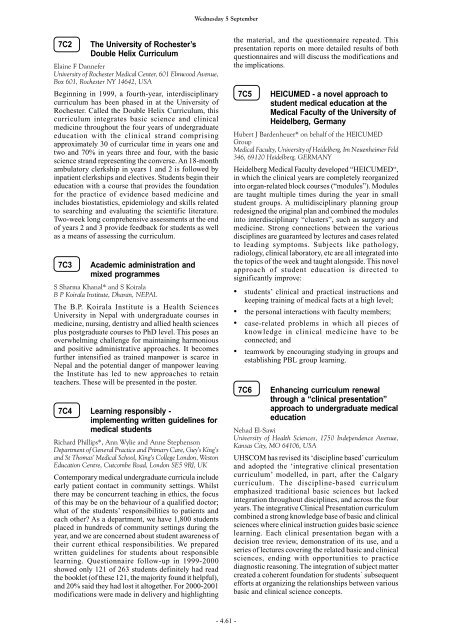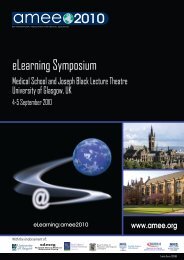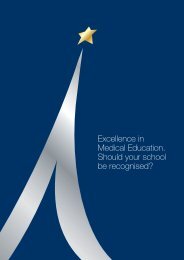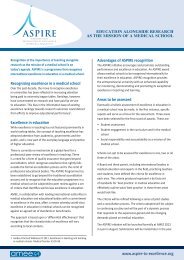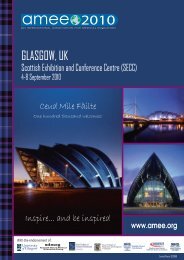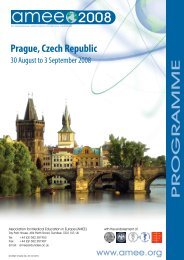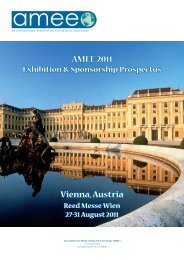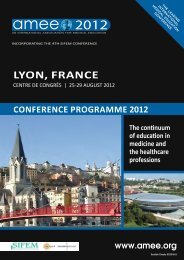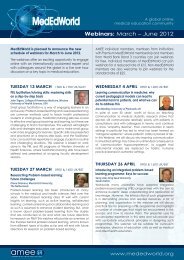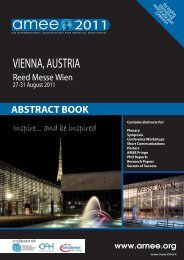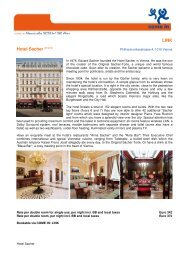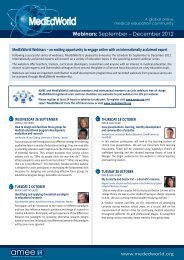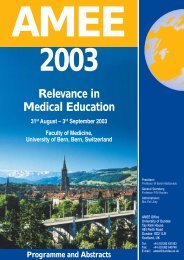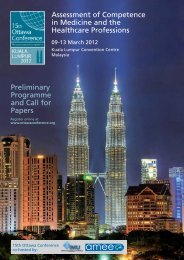AMEE Berlin 2002 Programme
AMEE Berlin 2002 Programme
AMEE Berlin 2002 Programme
Create successful ePaper yourself
Turn your PDF publications into a flip-book with our unique Google optimized e-Paper software.
7C2 The University of Rochester’s<br />
Double Helix Curriculum<br />
Elaine F Dannefer<br />
University of Rochester Medical Center, 601 Elmwood Avenue,<br />
Box 601, Rochester NY 14642, USA<br />
Beginning in 1999, a fourth-year, interdisciplinary<br />
curriculum has been phased in at the University of<br />
Rochester. Called the Double Helix Curriculum, this<br />
curriculum integrates basic science and clinical<br />
medicine throughout the four years of undergraduate<br />
education with the clinical strand comprising<br />
approximately 30 of curricular time in years one and<br />
two and 70% in years three and four, with the basic<br />
science strand representing the converse. An 18-month<br />
ambulatory clerkship in years 1 and 2 is followed by<br />
inpatient clerkships and electives. Students begin their<br />
education with a course that provides the foundation<br />
for the practice of evidence based medicine and<br />
includes biostatistics, epidemiology and skills related<br />
to searching and evaluating the scientific literature.<br />
Two-week long comprehensive assessments at the end<br />
of years 2 and 3 provide feedback for students as well<br />
as a means of assessing the curriculum.<br />
7C3 Academic administration and<br />
mixed programmes<br />
S Sharma Khanal* and S Koirala<br />
B P Koirala Institute, Dharan, NEPAL<br />
The B.P. Koirala Institute is a Health Sciences<br />
University in Nepal with undergraduate courses in<br />
medicine, nursing, dentistry and allied health sciences<br />
plus postgraduate courses to PhD level. This poses an<br />
overwhelming challenge for maintaining harmonious<br />
and positive administrative approaches. It becomes<br />
further intensified as trained manpower is scarce in<br />
Nepal and the potential danger of manpower leaving<br />
the Institute has led to new approaches to retain<br />
teachers. These will be presented in the poster.<br />
7C4 Learning responsibly -<br />
implementing written guidelines for<br />
medical students<br />
Richard Phillips*, Ann Wylie and Anne Stephenson<br />
Department of General Practice and Primary Care, Guy’s King’s<br />
and St Thomas’ Medical School, King’s College London, Weston<br />
Education Centre, Cutcombe Road, London SE5 9RJ, UK<br />
Contemporary medical undergraduate curricula include<br />
early patient contact in community settings. Whilst<br />
there may be concurrent teaching in ethics, the focus<br />
of this may be on the behaviour of a qualified doctor;<br />
what of the students’ responsibilities to patients and<br />
each other? As a department, we have 1,800 students<br />
placed in hundreds of community settings during the<br />
year, and we are concerned about student awareness of<br />
their current ethical responsibilities. We prepared<br />
written guidelines for students about responsible<br />
learning. Questionnaire follow-up in 1999-2000<br />
showed only 121 of 263 students definitely had read<br />
the booklet (of these 121, the majority found it helpful),<br />
and 20% said they had lost it altogether. For 2000-2001<br />
modifications were made in delivery and highlighting<br />
Wednesday 5 September<br />
- 4.61 -<br />
the material, and the questionnaire repeated. This<br />
presentation reports on more detailed results of both<br />
questionnaires and will discuss the modifications and<br />
the implications.<br />
7C5 HEICUMED - a novel approach to<br />
student medical education at the<br />
Medical Faculty of the University of<br />
Heidelberg, Germany<br />
Hubert J Bardenheuer* on behalf of the HEICUMED<br />
Group<br />
Medical Faculty, University of Heidelberg, Im Neuenheimer Feld<br />
346, 69120 Heidelberg, GERMANY<br />
Heidelberg Medical Faculty developed “HEICUMED“,<br />
in which the clinical years are completely reorganized<br />
into organ-related block courses (“modules”). Modules<br />
are taught multiple times during the year in small<br />
student groups. A multidisciplinary planning group<br />
redesigned the original plan and combined the modules<br />
into interdisciplinary “clusters”, such as surgery and<br />
medicine. Strong connections between the various<br />
disciplines are guaranteed by lectures and cases related<br />
to leading symptoms. Subjects like pathology,<br />
radiology, clinical laboratory, etc are all integrated into<br />
the topics of the week and taught alongside. This novel<br />
approach of student education is directed to<br />
significantly improve:<br />
• students’ clinical and practical instructions and<br />
keeping training of medical facts at a high level;<br />
• the personal interactions with faculty members;<br />
• case-related problems in which all pieces of<br />
knowledge in clinical medicine have to be<br />
connected; and<br />
• teamwork by encouraging studying in groups and<br />
establishing PBL group learning.<br />
7C6 Enhancing curriculum renewal<br />
through a “clinical presentation”<br />
approach to undergraduate medical<br />
education<br />
Nehad El-Sawi<br />
University of Health Sciences, 1750 Independence Avenue,<br />
Kansas City, MO 64106, USA<br />
UHSCOM has revised its ‘discipline based’ curriculum<br />
and adopted the ‘integrative clinical presentation<br />
curriculum’ modelled, in part, after the Calgary<br />
curriculum. The discipline-based curriculum<br />
emphasized traditional basic sciences but lacked<br />
integration throughout disciplines, and across the four<br />
years. The integrative Clinical Presentation curriculum<br />
combined a strong knowledge base of basic and clinical<br />
sciences where clinical instruction guides basic science<br />
learning. Each clinical presentation began with a<br />
decision tree review, demonstration of its use, and a<br />
series of lectures covering the related basic and clinical<br />
sciences, ending with opportunities to practice<br />
diagnostic reasoning. The integration of subject matter<br />
created a coherent foundation for students` subsequent<br />
efforts at organizing the relationships between various<br />
basic and clinical science concepts.


